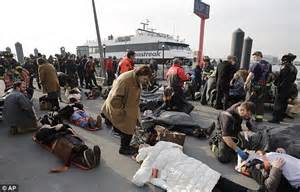The following is the text of a news release from the National Transportation Safety Board:
(WASHINGTON) (April 8) — The National Transportation Safety Board determined today that the ferry Seastreak Wall Street struck Pier 11 in Lower Manhattan in January 2013, because the captain lost control of the vessel while attempting to dock. Additionally, the procedure used by the captain to reduce speed and transfer control from one bridge station to another while approaching the pier did not allow enough time to adequately respond to the loss of propulsion control.
On January 9, 2013, Seastreak Wall Street, a high-speed passenger ferry serving commuters between New Jersey and Lower Manhattan, allided with Pier 11 as the vessel was attempting to dock. Four of the 331 persons aboard the vessel were treated for serious injuries.
"While the Seastreak Wall Street is the third ferry accident the NTSB has investigated in New York City in the last decade, we found areas of risk identified in previous investigations," said NTSB Chairman Deborah A.P. Hersman. "Seastreak LLC had no safety management system (SMS) in place to identify risks and take corrective actions. Although the NTSB recommended that SMS be required in 2005 and the Coast Guard was provided the authority to require them by Congress in 2010, SMSs are still not required for domestic passenger vessels. It is time to require that every passenger vessel implement an SMS."
A safety management system would have required the company to maintain current documents, to train employees to integrate safe practices into both routine vessel operations and emergency preparations and to clearly define the roles of the crew members, ensuring the captain had assistance during the emergency.
The captain lost control of the vessel because of confusion about the mode in which the ferry was operating. Earlier in the accident trip, the captain had taken the vessel from the normal combinator mode to the seldom-used backup mode; as he approached the dock, he was not aware he had not transferred the propulsion system back to combinator mode. In backup mode, the propellers remained in the forward pitch position, causing the vessel to increase forward speed rather than slow down.
Contributing to the severity of injuries was the lack of procedures to limit passenger access to stairwells on the Seastreak Wall Street during potentially high-risk situations such as docking and undocking. Immediately prior to the accident, no audible alarm was sounded nor did the captain make an announcement to inform passengers of the emergency.
In 2012, the Seastreak Wall Street underwent major modifications converting the vessel's engines from waterjet to controllable pitch propeller propulsion. Although vessel owners and operators are responsible for updating documents to reflect changes in equipment, the Seastreak's operating manual had not been updated. Additionally, following the changes, the company did not institute a formal training program on operation of the new system. However, the captain was trained by personnel from the manufacturer of the new system, and in turn trained other Seastreak captains on the new system.
The NTSB's investigation of this accident was also hampered by the absence of a voyage data recorder, which would have captured critical information to assist in the investigation.
As a result of this accident, the NTSB makes recommendations to:
- United States Coast Guard regarding human factors standards for critical vessel controls, the need for operator control of ferry passenger access to stairwells, and the carriage of marine voyage data recorders;
- The owner of the Seastreak Wall Street to improve specific control system displays and alerts, complete development and implementation of a safety management system, and revise its vessel operations and training manuals; and
- The manufacturer of the Seastreak Wall Street propulsion control system to improve its design and alert its customers to the changes.
- Additionally, three previously issued recommendations to the United States Coast Guard requiring the installation of voyage data recorders and the implementation of safety management systems were reclassified.

